The Intel Core Ultra 7 155H Review: Meteor Lake Marks A Fresh Start To Mobile CPUs
by Gavin Bonshor on April 11, 2024 8:30 AM ESTASUS Zenbook 14 OLED UX3405MA: Graphics Performance (Arc vs Radeon)
Moving onto gaming performance, Intel has gone all out for Meteor Lake when it comes to integrated graphics by incorporating their discrete-based Arc graphics into a more power-efficient mobile package. Designed with Arc performance for mobile, Intel includes their latest Arc Xe LPG graphics cores into Meteor Lake, which includes eight Xe cores designed to provide good performance levels.
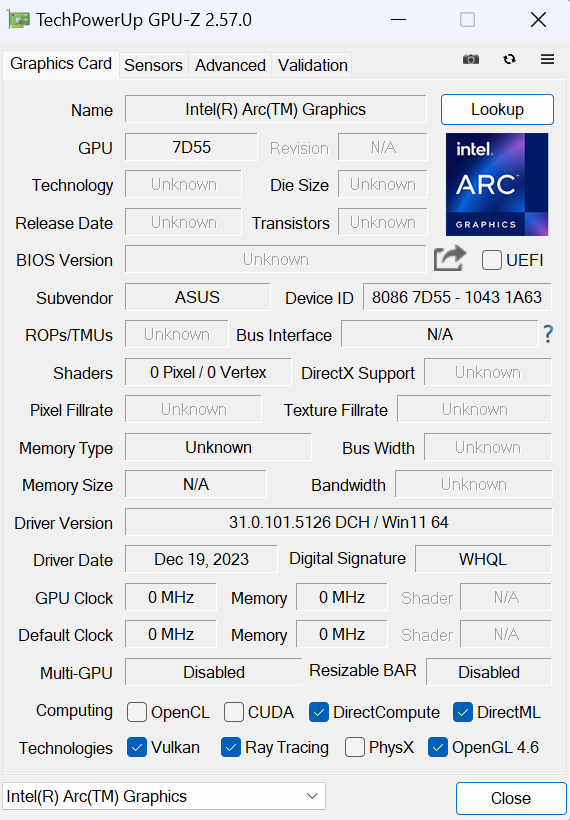
Screenshot of the Intel Core Ultra 7 155H with Arc Xe Graphics in GPU-Z
Regarding competition, AMD's mobile Radeon 780M and 760M graphics use their RNDA3 graphics architecture. The AMD Ryzen 9 7940HS and Ryzen 7 8700G both include the Radeon 780M, which includes twelve RDNA3 CUs, while the Ryzen 5 8600G uses the Radeon 760M, which is similar in design to the 780M but has just eight RDNA3 CUs. In relation to comparing both architectures, the Radeon 780M is Intel Meteor Lake's primary competition in the integrated mobile graphics arena.
Notably, here, the Ryzen 9 7940HS laptop is only using DDR5-5600 via SO-DIMMs, rather than soldered-down LPDDR5X. As a result it comes into this contest with a memory bandwidth deficit. Though by how much is uncertain, as current hardware info tools are not correctly reading the LPDDR5X memory speeds on Meteor Lake devices. Our best guess for now is that this would be paired with LPDDR5X-8533.
On the flip side, as we established with our look at power consumption, the Ryzen 9 7940HS laptop is able to sustain a much higher TDP overall – so that memory bandwidth deficit is counterbalanced by a sizable TDP advantage.
For this review, we will focus on gaming performance at 1080p, which is the most commonly used gaming resolution according to the latest Steam survey, and given these are mobile chips, we've opted for middle-of-the-road settings using the Medium preset.
Gaming Performance @ 1080p Medium Settings
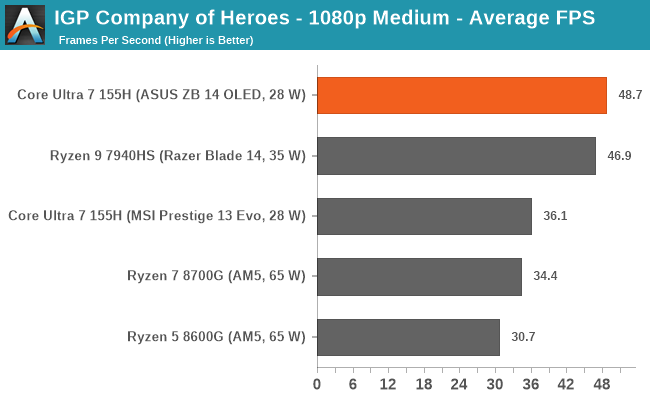
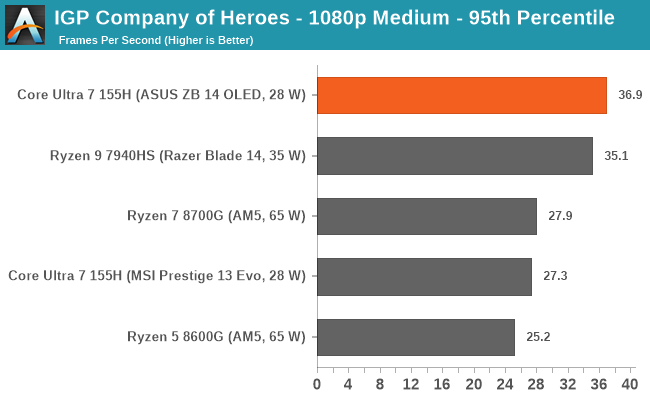
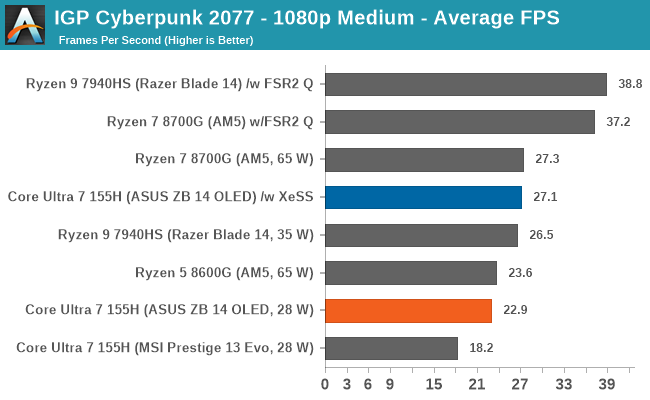
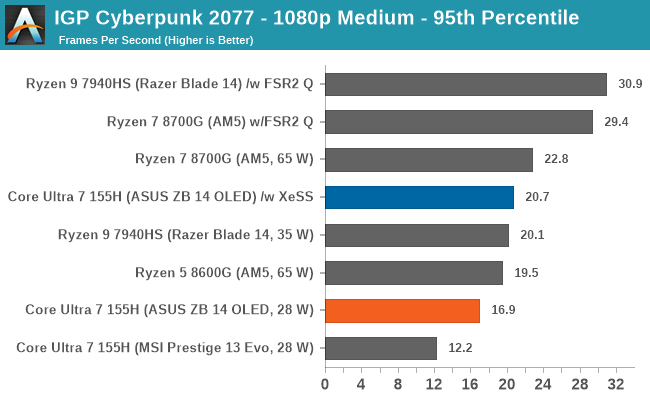
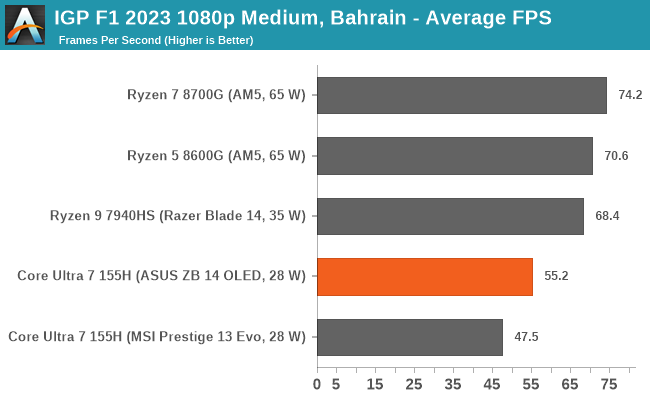
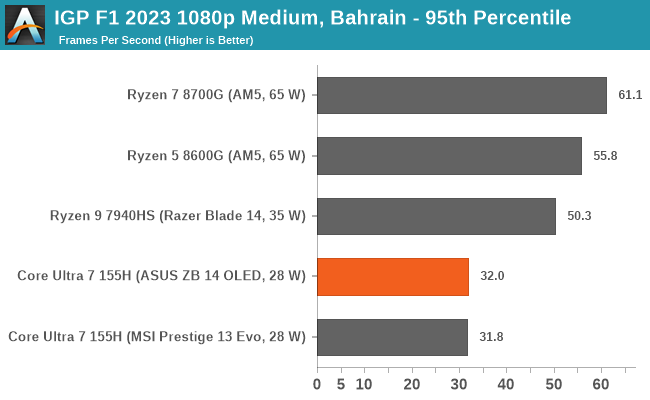
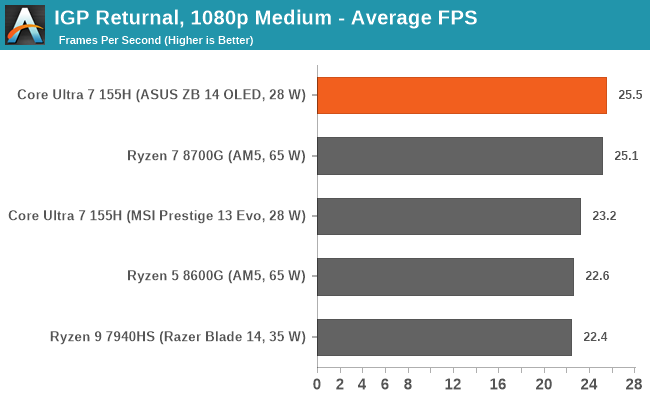

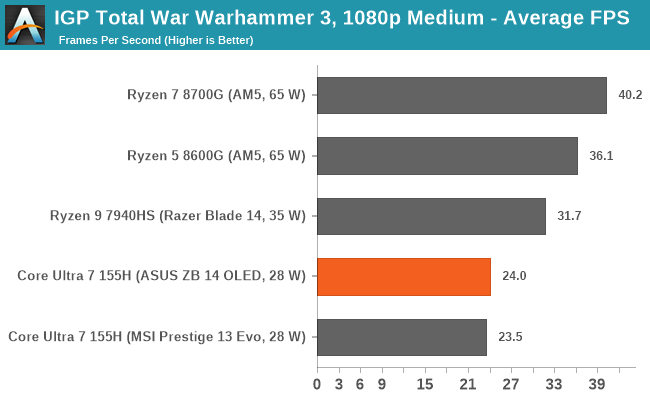

Looking at gaming performance with the 1080p resolution and medium preset across all the games, we can see that the ASUS Zenbook 14 OLED UX3405MA is very competitive with the Razer Blade 14 with the Radeon 780M chip in Company of Heroes 3. Looking at the other titles, such as Cyberpunk 2077 and F1 2023, we can see that performance lags slightly behind the integrated Arc Xe graphics when compared directly to AMD's RDNA3 architecture. The difference isn't night and day, but certainly enough to consider the Radeon 780M, the superior integrated graphics chip combined with the Zen 4 cores, even when set at 35 W.
In Returnal, Intel's Core Ultra 7 155H within the ASUS Zenbook 14 OLED performs very well, although in Total War Warhammer 3, the Meteor Lake chip displays fairly reasonable average frame rates but bottoms out massively in the 5% low framerates; this is on both the ASUS and MSI ultrabooks.
We can also see a pattern where the ASUS Zenbook 14 OLED is considerably ahead in some games than the MSI Prestige 13 Evo A1MG, despite featuring the same Core Ultra 7 155H processor. This is because the MSI notebook is actually smaller and ultimately runs with less power overall than the ASUS model. This is prevalent in our peak power testing.
Overall, there are certain benefits to Intel's Arc Xe LPG integrated graphics in Meteor Lake, and for the best part, it's competitive with the AMD Radeon 780M and 760M. We also feel that if the Intel pair of ultrabooks had better cooling, performance could be even greater, as we saw in our power analysis. That being said, Intel's Arc Xe LPG graphics work, and given that it's Intel's first go at a tiled architecture in their mobile portfolio, it provides a solid stepping stone to the next generation.










69 Comments
View All Comments
mode_13h - Wednesday, April 17, 2024 - link
I wonder if the reason they did it that way is to do with how programs which explicitly set affinity typically do so. The rationale might be something like:1. Make single-threaded programs and the main thread of multi-threaded programs fast.
2. For multi-threaded programs, the next set of threads should be efficiency-optimized. Reply
Marlin1975 - Thursday, April 11, 2024 - link
So it uses more power and still loses in most things to the AMD chipwow, I thought intel was getting better and this is all they have? Let alone AMDs newer Zen5 chips are coming soon and will only move their lead further. Reply
Pheesh - Thursday, April 11, 2024 - link
well, it definitely isn't using more power, perhaps you skipped over the battery/power section? A lot less power during general office type usage, despite a thinner chassis that can deal with much less thermals etc. But the laptops being compared are so vastly different this whole review seems kinda....meaningless? The razer 14 is a 4lb gaming laptop, with thermals to boot, in a comparatively massive chassis. And it's being compared against a macbook air esque form factor. The reader isn't gaining much from a comparison to another processor that does not exist in a comparable form factor/power envelope. ReplyRyan Smith - Thursday, April 11, 2024 - link
Ultimately that's down to AMD and Intel. One sampled a 42W notebook for their mobile CPU launch, the other sampled a 28W notebook. We've equalized things as much as we can, but we can only test what we have (or in the case of the MSI, get our hands on). Replytipoo - Thursday, April 11, 2024 - link
M3 would be a great comparison point ReplyTheinsanegamerN - Thursday, April 11, 2024 - link
M3 is an entirely different arch, in a different OS ecosystem, with its own special API. You're comparing apples and giraffes. Replymode_13h - Monday, April 15, 2024 - link
For those apps which run on both machines, it's absolutely a valid comparison. If all the apps you need are supported on both, then it's useful to see how they compare because you really could pick either one. Replymode_13h - Monday, April 15, 2024 - link
Toms' review includes M3, however they only have a few benchmarks. It's not as comprehensive a review as this one.https://www.tomshardware.com/laptops/ultrabooks-ul... Reply
clemsyn - Thursday, April 11, 2024 - link
Thanks for the review. Looks like Intel is waking up and going the right direction. I just hope its not too late (which I think it is). Replymeacupla - Thursday, April 11, 2024 - link
135H has 8 Xe cores, not 7 Reply